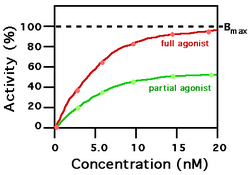Partial Agonist
 From Handwiki
From Handwiki 
In pharmacology, partial agonists are drugs that bind to and activate a given receptor, but have only partial efficacy at the receptor relative to a full agonist. They may also be considered ligands which display both agonistic and antagonistic effects—when both a full agonist and partial agonist are present, the partial agonist actually acts as a competitive antagonist [citation needed], competing with the full agonist for receptor occupancy and producing a net decrease in the receptor activation observed with the full agonist alone.[1] Clinically, partial agonists can be used to activate receptors to give a desired submaximal response when inadequate amounts of the endogenous ligand are present, or they can reduce the overstimulation of receptors when excess amounts of the endogenous ligand are present.[2]
Some currently common drugs that have been classed as partial agonists at particular receptors include buspirone, aripiprazole, buprenorphine, nalmefene and norclozapine. Examples of ligands activating peroxisome proliferator-activated receptor gamma as partial agonists are honokiol and falcarindiol.[3][4] Delta 9-tetrahydrocannabivarin (THCV) is a partial agonist at CB2 receptors and this activity might be implicated in ∆9-THCV-mediated anti-inflammatory effects.[5] Additionally, Delta-9-Tetrahydrocannabinol (THC) is a partial agonist at both the CB1 and CB2 receptors, with the former being responsible for its psychoactive effects.
See also
- Competitive antagonist
- Intrinsic sympathomimetic activity of beta blockers
- Inverse agonist
- Mixed agonist/antagonist
References
- ↑ Calvey, Norman; Williams, Norton (2009). "Partial agonists". Principles and Practice of Pharmacology for Anaesthetists. John Wiley & Sons. p. 62. ISBN 978-1-4051-9484-6. https://books.google.com/books?id=lnRlU12Q4h8C&pg=PA62.
- ↑ "Mechanistic explanation for the unique pharmacologic properties of receptor partial agonists". Biomedicine & Pharmacotherapy 59 (3): 76–89. April 2005. doi:10.1016/j.biopha.2005.01.010. PMID 15795100.
- ↑ "Honokiol: a non-adipogenic PPARγ agonist from nature". Biochimica et Biophysica Acta (BBA) - General Subjects 1830 (10): 4813–9. October 2013. doi:10.1016/j.bbagen.2013.06.021. PMID 23811337.
- ↑ "Polyacetylenes from Notopterygium incisum--new selective partial agonists of peroxisome proliferator-activated receptor-gamma". PLOS ONE 8 (4): e61755. 2013. doi:10.1371/journal.pone.0061755. PMID 23630612. Bibcode: 2013PLoSO...861755A.
- ↑ "PHARMACOLOGICAL PROPERTIES OF THE PHYTOCANNABINOIDS ∆9-TETRAHYDROCANNABIVARIN AND CANNABIDIOL - Phd thesis of: Dr. Daniele Bolognini - PDF". 2010. http://insubriaspace.cineca.it/bitstream/10277/269/1/Phd_thesis_bolognini_completa.pdf.
 |
Categories: [Pharmacodynamics]
↧ Download as ZWI file | Last modified: 07/18/2024 03:20:26 | 17 views
☰ Source: https://handwiki.org/wiki/Chemistry:Partial_agonist | License: CC BY-SA 3.0

 KSF
KSF